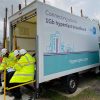Warning of Challenges Ahead for Investment in UK Gigabit Broadband

A new report from the UK Internet Service Providers Association (ISPA), which examined the appetite for investment in alternative broadband networks (AltNets) by interviewing leading investors, has warned that the market has “reached saturation point” and those looking for further rounds of investment will find new challenges.
At present around 70% of UK premises can already access a gigabit-capable broadband connection and that drops to around 40% when only looking at Fibre-to-the-Premises (FTTP) networks. The figure has improved significantly over the past 3-4 years, which is in no small part due to the mass of over a hundred alternative network (AltNet) providers that have entered the market, often backed by significant levels of private investment.
According to a recent report from the Independent Networks Co-operative Association (INCA), alternative “full fibre” broadband networks grew their UK coverage by 111% in 2021 to cover 5.46 million premises and they’ll probably double that again this year. The same report noted that investment and expenditure commitments in altnets totalled £5.7 billion up until the end of 2021 and could reach £17.7bn by 2025.
Advertisement
Suffice to say that, so far, AltNets have had plenty of success in attracting the initial investment they need to get started, but reaching their future coverage goals will require additional funding. Securing that is likely to become more of a challenge, given how saturated the market has become with operators – many of which are starting to overbuild each other and thus stretching the viability of their competitive investment models (i.e. achieving payback for investors becomes harder).
As we’ve said many times before, the inevitable outcome of reaching this saturation point is that it will result in a period of natural market consolidation and the rise in overbuild will inevitably cause investors to focus on an operator’s ability to convert that build into a reasonable level of customer take-up and revenue. Some will succeed in this, while others will struggle, and investors will naturally tighten their purse strings.
We should point out that the above largely reflects private investment in urban and sub-urban builds, where there’s currently no shortage of private investment to tackle the problem (i.e. the first 80% of premises should easily be covered by commercial gigabit builds by 2025). However, premises in the final 20% of the UK are likely to need public support, which is what the Government’s £5bn Project Gigabit scheme aims to tackle.
The goal is to make gigabit-capable networks available to at least 85% of UK premises by the end of 2025 (commercial deployments alone should hit about 80%+) and then “at least” 99% by 2030, but there are still a few question marks over how altnet friendly the gap-funded contracts under Project Gigabit will be.
Advertisement
Findings of the new report
The ISPA’s new report – ‘WHAT LIES AHEAD: ISPA ALTNET GIGABIT BROADBAND INVESTOR REPORT‘ (sponsored by TV provider Netgem) – largely echoes the above points and warns that “providers looking for further rounds of investment are likely to find a different landscape to the one in which they raised their original funding. It will take longer to achieve funding and may be harder to come by.”
Charles Cameron, Partner at Cameron Barney, said:
“We have seen a ballooning of participants that it is simply not practical and I expect to see a slimming down to a considerably smaller number. With the end of the landgrab in sight, investors will become increasingly focused on customer service and retention, profitability and network asset performance.”
One other commonly held view amongst interviewees was that Ofcom “doesn’t quite have a full grasp of the ambition of the sector” as a whole, particularly when it comes to build programmes and the impact on particular regions. We’ve certainly seen that the regulator has, at times, had a tendency to disregard the collective concerns of smaller AltNets, although Ofcom does admittedly have a difficult job in needing to filtering through a mass of competing / vested interests.
Nevertheless, the respondents believe that regulators have a natural bias towards larger players (e.g. Openreach) that “can get things done quickly“, and that they would “prefer to deal with a single organisation that can build nationwide quickly and efficiently, as opposed to 100 people that can build for the same amount of homes.” The irony being that “too much competition and diversification (a regulatory goal)” has complicated matters.
Summary of Key Opinions
➤ To help secure long-term funding from investors, providers must differentiate their services from competitors. As gigabit speeds cease to be a key determining factor for consumers, providers must think creatively about what they offer to customers.
➤ The impact of consolidation is also likely to mean a greater role for wholesale in the future, and the increase in infrastructure competition of recent years will mean consumers will have a greater choice of options.
➤ Fibre-to-the-Premise (FTTP) take-up will be supported by key developments in the broadband industry, such as Ofcom’s introduction of a ‘One Touch Switch’ initiative by April 2023.
➤ The policy environment can best support fibre rollout by removing red tape and barriers to deployment and the regulator should take a greater account of greater infrastructure competition brought about by the market.
In terms of improving the policy environment, respondents called on the Government to “relax immigration rules” to help with the shortage of skilled fibre engineers. The Home Office is already working on something for this, but they’ve been frustratingly slow to tackle it. On top of that, there’s a call for more demand-side measures to increase awareness of gigabit broadband, which would complement Ofcom’s new OTS switching process.
Advertisement
Moreover, the contentious issue of how fibre is advertised was raised repeatedly, with a feeling that many consumers remain unaware that their Fibre-to-the-Cabinet (FTTC / VDSL2) service is not as reliable or fast as FTTP. While the advertising watchdog (ASA) looked and rejected this issue some years ago, it was argued, widespread fibre availability meant it was time to look again. The Gigabit Take-Up Advisory Group (GigaTAG) also raised this issue, but we’re still awaiting some movement on their proposals.
However, we were surprised to see no calls for a reintroduction – at least in England and Wales – of a business rates holiday on new fibre, which is a policy that came to an end earlier this year. Scotland is continuing to offer such relief and has roughly matched it to the expected payback periods for investment in new full fibre networks (i.e. 10 years+), which is something that Westminster has shown little interest in mirroring.
Overall, the ISPA’s report largely echoes our own thoughts on this sector, but it’s worth noting that the findings were based on feedback conducted via just five interviews (under the Chatham House rule) with representatives of Digital Infrastructure Investing, Cameron Barney, Infracapital, DIF Capital Partners and Octopus Investments. All key players, albeit ones with a very particular interest. We would have liked to get the perspective of AltNets too.
Mark is a professional technology writer, IT consultant and computer engineer from Dorset (England), he also founded ISPreview in 1999 and enjoys analysing the latest telecoms and broadband developments. Find me on X (Twitter), Mastodon, Facebook, BlueSky, Threads.net and Linkedin.
« BT and Vodafone UK Reiterate Desire to Make Netflix etc. Pay























































Comments are closed